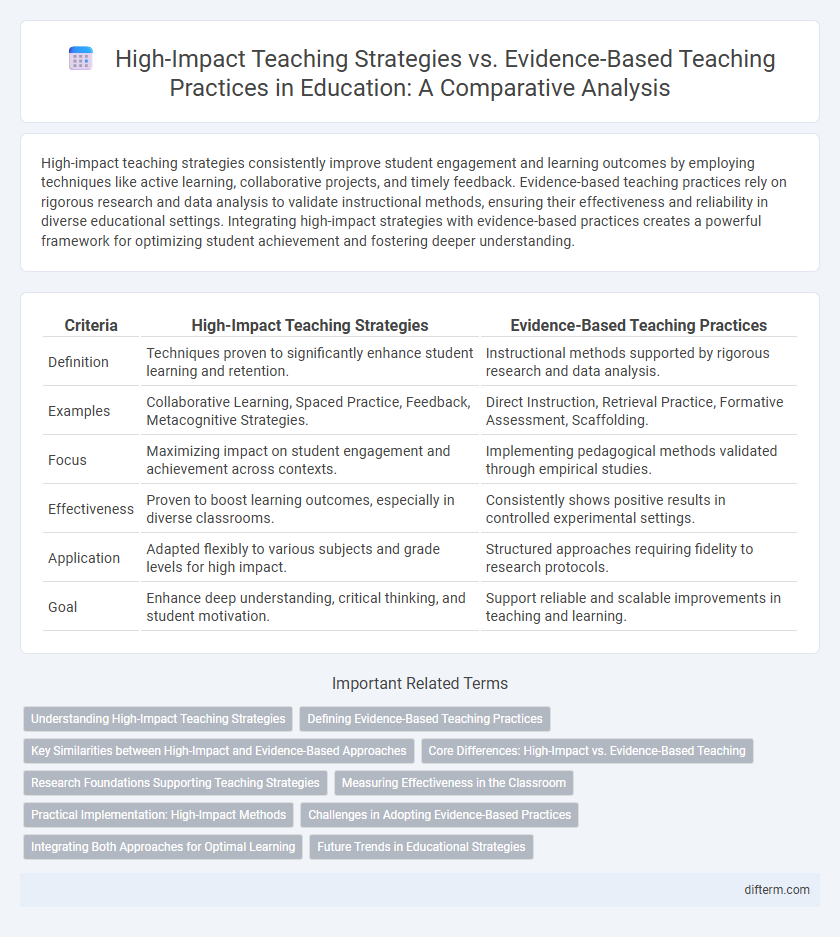High-impact teaching strategies consistently improve student engagement and learning outcomes by employing techniques like active learning, collaborative projects, and timely feedback. Evidence-based teaching practices rely on rigorous research and data analysis to validate instructional methods, ensuring their effectiveness and reliability in diverse educational settings. Integrating high-impact strategies with evidence-based practices creates a powerful framework for optimizing student achievement and fostering deeper understanding.
Table of Comparison
| Criteria | High-Impact Teaching Strategies | Evidence-Based Teaching Practices |
|---|---|---|
| Definition | Techniques proven to significantly enhance student learning and retention. | Instructional methods supported by rigorous research and data analysis. |
| Examples | Collaborative Learning, Spaced Practice, Feedback, Metacognitive Strategies. | Direct Instruction, Retrieval Practice, Formative Assessment, Scaffolding. |
| Focus | Maximizing impact on student engagement and achievement across contexts. | Implementing pedagogical methods validated through empirical studies. |
| Effectiveness | Proven to boost learning outcomes, especially in diverse classrooms. | Consistently shows positive results in controlled experimental settings. |
| Application | Adapted flexibly to various subjects and grade levels for high impact. | Structured approaches requiring fidelity to research protocols. |
| Goal | Enhance deep understanding, critical thinking, and student motivation. | Support reliable and scalable improvements in teaching and learning. |
Understanding High-Impact Teaching Strategies
High-impact teaching strategies include techniques such as collaborative learning, frequent formative assessments, and providing timely feedback, which significantly enhance student engagement and retention. These strategies are designed to create deeper understanding and practical application of knowledge, often supported by active learning environments. Understanding high-impact teaching strategies allows educators to tailor instruction that maximizes student success and promotes meaningful learning outcomes.
Defining Evidence-Based Teaching Practices
Evidence-based teaching practices are instructional methods and strategies grounded in rigorous research and empirical data demonstrating their effectiveness in improving student learning outcomes. These practices include techniques such as formative assessment, spaced repetition, and explicit instruction, all supported by consistent positive results across diverse educational settings. Unlike high-impact teaching strategies, evidence-based practices rely specifically on validated evidence from peer-reviewed studies to guide classroom implementation.
Key Similarities between High-Impact and Evidence-Based Approaches
High-impact teaching strategies and evidence-based teaching practices both prioritize student engagement and active learning to improve academic outcomes. These approaches rely on research and data-driven methods to implement techniques such as feedback, collaborative learning, and formative assessment. Both emphasize continuous improvement through reflective teaching and the use of measurable indicators to enhance instructional effectiveness.
Core Differences: High-Impact vs. Evidence-Based Teaching
High-impact teaching strategies focus on engaging students through dynamic, experiential learning activities that promote deep understanding and retention, often tailored to specific disciplines. Evidence-based teaching practices rely on rigorous research and data analysis to implement methods proven to enhance learning outcomes across diverse educational settings. The core difference lies in high-impact strategies emphasizing transformative student experiences, while evidence-based practices prioritize validated, replicable instructional techniques grounded in scientific evidence.
Research Foundations Supporting Teaching Strategies
High-impact teaching strategies are grounded in extensive research that identifies methods yielding significant improvements in student learning outcomes, such as active learning and formative assessment. Evidence-based teaching practices rely on rigorous empirical studies that validate their effectiveness across diverse educational settings, emphasizing techniques like spaced repetition and retrieval practice. Both approaches draw from a growing body of meta-analyses and randomized controlled trials confirming the positive impact of well-designed instructional interventions on student achievement.
Measuring Effectiveness in the Classroom
High-impact teaching strategies significantly enhance student learning outcomes by targeting deep engagement and cognitive challenge, whereas evidence-based teaching practices rely on rigorous research to validate their effectiveness. Measuring effectiveness in the classroom involves analyzing student performance data, formative assessments, and feedback to determine the impact of each approach on knowledge retention and skill development. Combining quantitative metrics with qualitative observations helps educators refine instructional methods for optimal academic achievement.
Practical Implementation: High-Impact Methods
High-impact teaching strategies prioritize practical implementation through active learning, frequent feedback, and collaborative projects that enhance student engagement and retention. Evidence-based teaching practices support these methods by grounding them in research validating their effectiveness across diverse educational settings. Integrating real-world applications and continuous assessment ensures that high-impact strategies translate theory into measurable student success.
Challenges in Adopting Evidence-Based Practices
Educators often face significant challenges in adopting evidence-based teaching practices due to limited access to current research, inadequate professional development, and resistance to change within institutional cultures. High-impact teaching strategies, while widely recognized for improving student engagement and learning outcomes, may not always align seamlessly with evidence-based methods, creating tension in implementation. Overcoming these barriers requires systemic support, including sustained training, resource allocation, and fostering a culture that values continuous improvement grounded in empirical evidence.
Integrating Both Approaches for Optimal Learning
Combining high-impact teaching strategies such as active learning and collaborative projects with evidence-based teaching practices like spaced repetition and formative assessment creates a robust framework for maximizing student engagement and retention. Integrating these approaches fosters deep understanding by leveraging empirical data to guide instructional design while maintaining dynamic, interactive classroom environments. This synthesis enhances learning outcomes by addressing diverse student needs through research-backed methods paired with impactful, student-centered activities.
Future Trends in Educational Strategies
High-impact teaching strategies leverage innovative methods such as project-based learning and formative assessments to enhance student engagement and retention. Evidence-based teaching practices rely on rigorous research, emphasizing techniques like spaced repetition and retrieval practice to improve learning outcomes. Future trends in educational strategies highlight the integration of artificial intelligence and adaptive learning technologies to personalize instruction and optimize student success.
High-impact teaching strategies vs Evidence-based teaching practices Infographic

 difterm.com
difterm.com